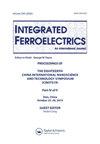The Fundamental Gamma Rays and Charge Particle Interactions of the CeBr 3 Scintillator
IF 0.7
4区 工程技术
Q4 ENGINEERING, ELECTRICAL & ELECTRONIC
引用次数: 0
Abstract
Abstract The research aims to study the primary interaction between gamma radiation in CeBr3 crystal. The analysis of mass attenuation coefficient (MAC), effective atomic number (Z eff), electron density (N eff), mean free path (MFP), and energy absorption buildup factor (EABF) was evaluated using the using the WinXCom software. Also, the interaction with charged particles as the total mass stopping power (TMSP), projected range (PR) of proton ( ) and alpha ( ) particles were evaluated by SRIM programming. The results found that the MAC depends on the energy ranges, the photoelectric effect is the main interaction at low energy ranges, Compton scattering phenomena illustrate and evidents at intermediate energy ranges, and pair production characteristics dominate over on 1.022 MeV in high energy ranges. Moreover, absorption edges appear on energy’s discontinuity at low energy. The Z eff and N eff show similar trends and correspond to the energy ranges. The MFP of the CeBr3 compared with some standard scintillators such as NaI and BGO crystal and found that the BGO responds to faster interaction than CeBr3 and NaI crystals. The EABF shows scattering energies followed by atomic equivalent (Z eq), and they also increase with increasing penetration depth (mfp). The TMSP and PR depend on charged particles, density, and the unit path distance of a material.cebr3闪烁体的基本伽马射线和电荷粒子相互作用
本文章由计算机程序翻译,如有差异,请以英文原文为准。
求助全文
约1分钟内获得全文
求助全文
来源期刊

Integrated Ferroelectrics
工程技术-工程:电子与电气
CiteScore
1.40
自引率
0.00%
发文量
179
审稿时长
3 months
期刊介绍:
Integrated Ferroelectrics provides an international, interdisciplinary forum for electronic engineers and physicists as well as process and systems engineers, ceramicists, and chemists who are involved in research, design, development, manufacturing and utilization of integrated ferroelectric devices. Such devices unite ferroelectric films and semiconductor integrated circuit chips. The result is a new family of electronic devices, which combine the unique nonvolatile memory, pyroelectric, piezoelectric, photorefractive, radiation-hard, acoustic and/or dielectric properties of ferroelectric materials with the dynamic memory, logic and/or amplification properties and miniaturization and low-cost advantages of semiconductor i.c. technology.
 求助内容:
求助内容: 应助结果提醒方式:
应助结果提醒方式:


